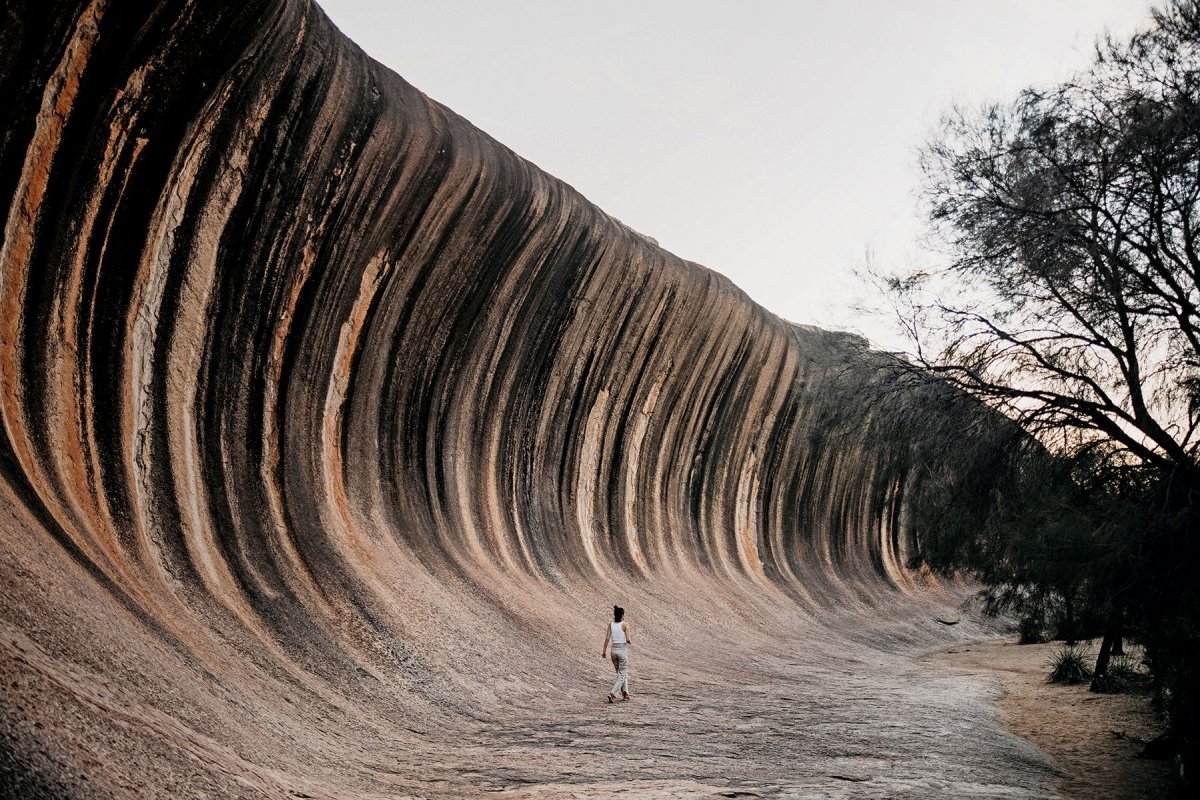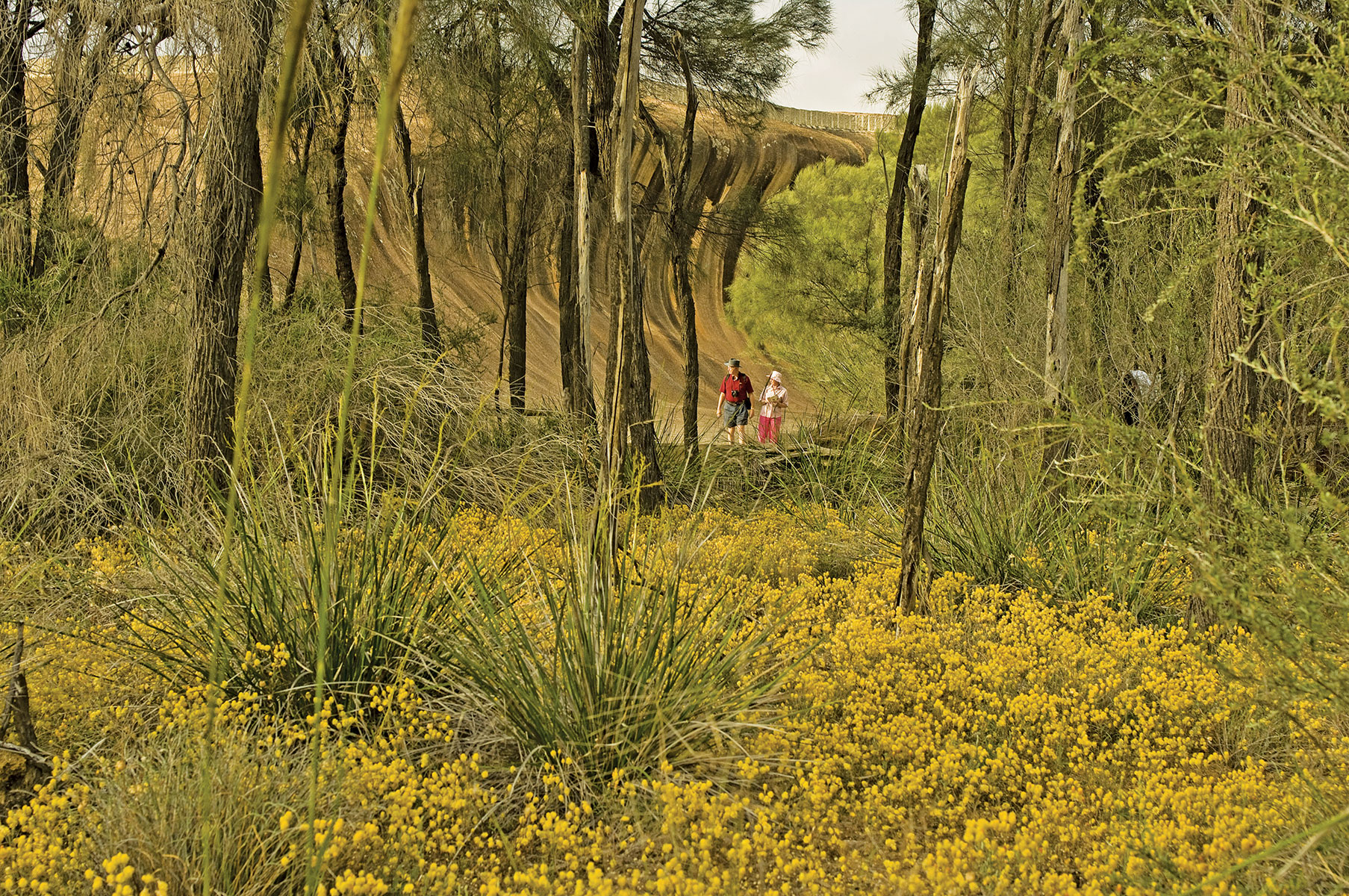Riding the wave: Wave Rock, Western Australia

Travelling Western Australia's Wheatbelt region during the springtime rewards handsomely. It becomes a region in bloom, where wildflowers and yellow seas of canola fields take over. It's a stark contrast to what it is like for the remainder of the year, where the more inland you go, the more barren it becomes — or so it seems.
One attraction offers permanent adoration and thrills between arid and woodlands. Some 336km east of Perth via Brookton Highway is Wave Rock / Katter Kich. Its name is to the point. The geological wonder is the state's most famous break despite it being nowhere near the coast. Hyden is the closest town to the granite cliff resembling a wave, a perfect soft-adventure destination for a weekend break with a few off-kilter surprises.
A natural icon
It took my father and I just under four hours to drive to Hyden from Perth. More than 150,000 visitors per year descend on the Wheatbelt town of Hyden with a population just shy of 500 to see the remarkable natural formation that looms over the hamlet. It was also my first time visiting the WA landmark that caught global attention in 1963 after an image of it won a photo competition and subsequently appeared in National Geographic magazine.
Wave Rock is roughly 2.7 billion years old, with the ochre and black tiger-striped rock curling 15m high into the air and 110fm long. The wave-shaped rock is located on the north side of Hyden Rock. There’s hardly any build-up of anticipation for viewing the rock’s curvier side; its banded grandeur is quickly realised on the 100m walk from the car park.
 Top of Wave Rock (Image Tourism WA)
Top of Wave Rock (Image Tourism WA)
An inland wave rises from outback plains, a break ceasing to recede. I felt so small standing under the wave's lip. Hardly an original pose, I joined other wave chasers along the stretch, standing goofy-footed with hands out and posing like a surfer for a quirky photo op. This wave is the only break where I will always be ahead of the curve.
Although far from the ocean, the movement of water shaped its formation. Millions of years ago, the water level was at the top of the wave. Over time, the water that ran off Hyden Rock penetrated through the granite outcrop's cracks. Although the rock's subsoil was deeply soaked, the top remained dry. With the rock underneath rotting away, it eventually led it to crumble and create a flared slope or wave.
 Visit Wave Rock in Spring for a riot of wildflowers (Image Tourism WA)
Visit Wave Rock in Spring for a riot of wildflowers (Image Tourism WA)
We stepped out from the famed rounded overhang to view the rest of the unusual formation following the Hyden Rock Walk. The 1.3km loop walking trail follows from the Wave Rock Walk, which departs from the car park to the foot of the wave and continues to the top of the timeworn outcrop with interpretation panels along the way.
At the end of the wave is a steel staircase to reach the top of Hyden Rock. Ironically, next to the wave is Hyden Dam, which serves the town. Large boulders — big enough to stand under — speck across the plateau. Closer to the waves' edge is a 1920s-built stone wall to pivot rainwater to the dam. The views are incredible regardless of where you stand on top of the rock, observing a patchwork of towering woodlands, farmlands, parched hills, salt lakes and other granite outcrops.
The top of the rock was dotted with small groups of people to watch the sunset, a perfect vantage point and, for some with better foresight, a picnic spot. From the rock's frozen ripple (ledge), we watched the scenery intensify in colour. It was a profound experience.
Rock on
Wave Rock isn't the only standout rock in the region.

Hippo’s Yawn is the region's other oversized wonder, just a 1.7km easy-grade loop from the Wave Rock car park. Millions of years of erosion have sculptured the cave to mimic the wide mouth of a hippopotamus — nostril indents included.
Another rock that captures the imaginations of many is Mulka's Cave, located 18km north of Wave Rock, within The Humps Nature Reserve. The cave is one of WA's most significant rock art sites due to its high density of motifs. It features 452 artworks, including hand stencils, reddish handprints, ancient rock paintings, and drawings in three chambers.

Aboriginal legend has it that the cave was named after an illegitimate son of a woman who fell in love with a man, their union outlawed. Because of their forbidden love, she gave birth to a son with crossed eyes. Due to his impairment, he couldn't hunt properly and ate children to survive, becoming a much-feared figure. He lived in the cave as a safe haven, and his handprint impressions can be seen higher than the other handprints found.
From the cave, there are two walking trails — Kalari and Gnamma — to explore the surrounding granite outcrops known as The Humps. We embarked on the moderate 1.8km Kalari trail, which included a steep climb to summit The Humps. Large boulders and shallow gnammas fleck the patched reddish-brown outcrop with interpretative panels highlighting flora, fauna and many Indigenous stories along the way.
A town of collectors
It was time to see some animation in the area. Wave Rock Wildlife Park is sprawled over three hectares of native bushland, just 500m from Wave Rock. It contains over 40 simple enclosures, including a who's who of native Australian animals: koalas, wombats, golden and ringtail possums, rare white kangaroos, and wallabies. Farm favourites such as alpacas, pheasants and peacocks also call the family-managed park home.

The other half of the park features a roll call of bird species — numerous cockatoos, wedge-tail eagles, galahs, lorikeets, werros, corellas and more — among large dinosaur sculptures.
We spent over an hour wandering around the park; perhaps anticipate a longer visit if kids are involved.
 There are plenty of animals to see at Wave Rock Wildlife Park (Image Tourism WA)
There are plenty of animals to see at Wave Rock Wildlife Park (Image Tourism WA)
Hyden's other amusement park comes as a true outback oddity — a lace museum. The Lace Place displays one of Australia's most extensive collections of lace, with snippets dating back to the 1600s. Confined to one room, the small museum details the history of lace making and the variety of laces with mannequins showcasing timeworn pieces.

The museum's most prized possessions come from royalty, with offcuts from Princess Diana's wedding veil and a Chantilly from Queen Victoria's gown on display. It is a kooky yet remarkable outback exclusive.
More magic to be found
Although Hyden's famous surf remains dry, there's another way to make a splash in town.
 Magic Lake (Image Tourism WA)
Magic Lake (Image Tourism WA)
Minutes from Wave Rock is Lake Magic. The lake is WA's version of the Dead Sea, with its high salt-density lake making it a tough slog to sink. Surrounded by sandy shores, the inland beach gets its name from the gypsum minerals found at the base, causing the lake to change colours — whites, yellows, orange, blues — throughout the day.
 Magic Lake Swimming Pond (Image Tourism WA)
Magic Lake Swimming Pond (Image Tourism WA)
For a luxury float, we headed to Magic Lake Swimming Pond, 800m from Wave Rock. The entry fee is included with a stay at Wave Rock Caravan Park & Resort, and the pond is within short walking distance from the campground with its shady salmon gum trees. The circular bubble-gum blue pond is surrounded by simple cabanas with day beds and changing blocks to make a day of being buoyant in the bush.
With the sun beating down, we opt for an express dip session in the pond. Another cheap thrill and surprise therapy session, with skin feeling great afterwards.
Toast to adventure
What better way to cap off 48 hours of unusual adventures than with a nourishing feed at Wave Rock Bar & Bistro. The bush bistro is attached to the Wave Rock Hotel, 5km from its namesake. It offers a different pub experience, allowing guests to cook meat on an indoor barbecue.
Although sounding no different from cooking dinner at the caravan park, it was a nice change of scene, mingling with other travellers in wooden cabin comforts, flipping locally sourced Mallee rump steak to your liking with a salad bar at your peril. Of course, if you want to avoid cooking your own meal, the restaurant has an a la carte menu.
After all the wave chasing and hiking of multiple outcrops, the wholesome dining experience was a great way to cap off 48 hours of making waves in the outback.

Fast Facts
Entrance to Wave Rock is $12 per vehicle.
Wave Rock Caravan Park & Resort
P: 08 9880 5022
E: waverock@wn.com.au
Wave Rock Hotel
P: 08 9880 5041 / 0429 511 511
E: hydenhotel@bigpond.com.au
Wave Rock Wildlife Park
P: 08 9880 5182
E: waverock@wn.com.au
The Lace Place
P: 08 9885 05052
E: waverock@wn.com.au
A new tool to plan your next WA getaway
Western Australian Museum's new online portal, WAnderland, showcases 220 of the most intriguing private and public collections across the state.
The interactive website features some of the most interesting places, stories and collections and includes a special tool to build your itinerary with these pitstops for the curious.
Each year, Western Australia’s famous wave plays host to an intimate and boutique music festival over the King’s Birthday long weekend in September. Hosted by Wave Rock Caravan Park, the three-day camping festival features a lineup of roughly 20 Australian and international acts with light displays projected on the prehistoric rock and incredible stargazing opportunities.
THE NEXT STEP
Are you ready to experience the freedom of the open road? Don't wait - Find your dream getaway now!
RELATED ARTICLES:
Ferguson Valley, Western Australia: A little-known treasure







